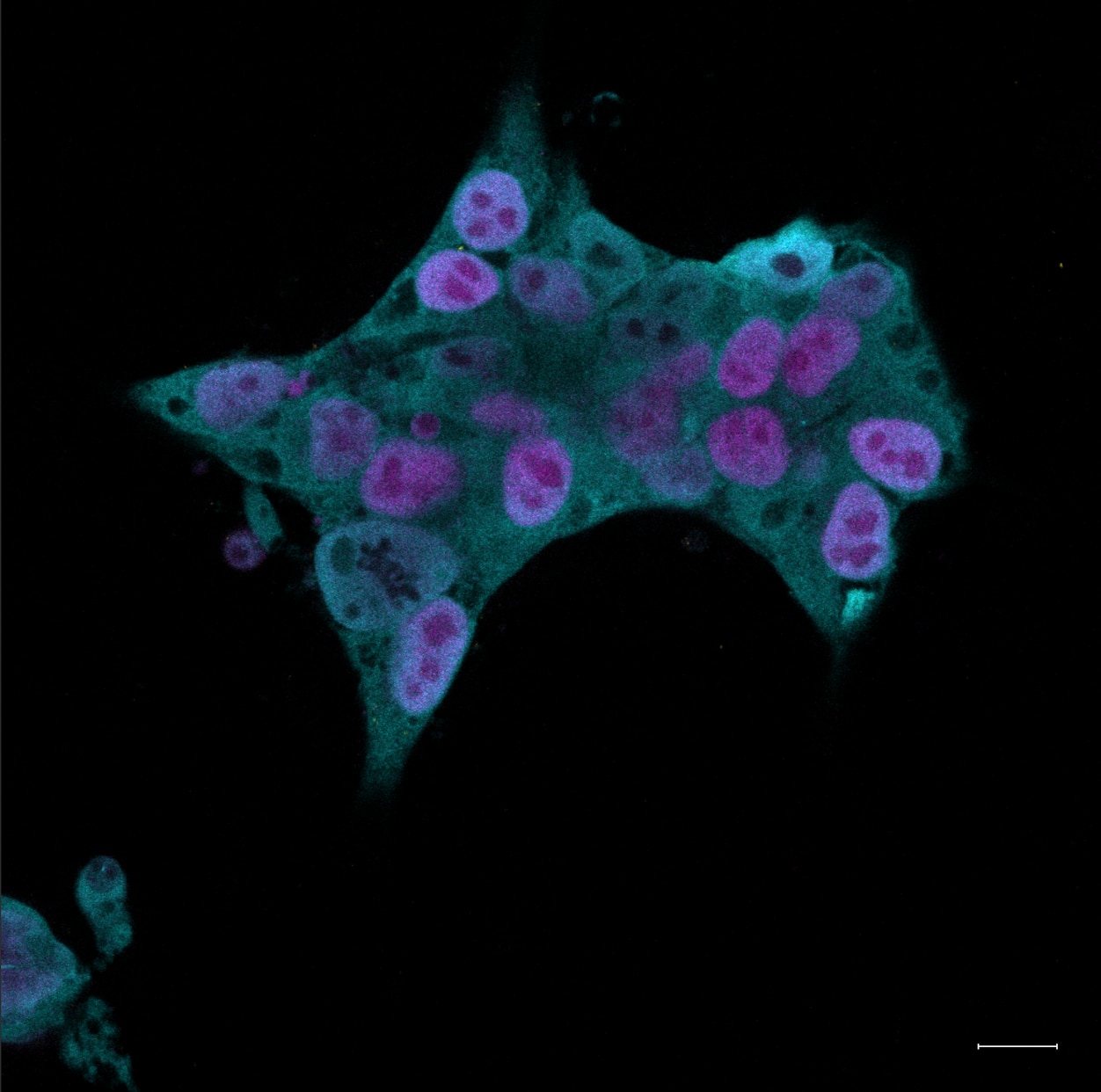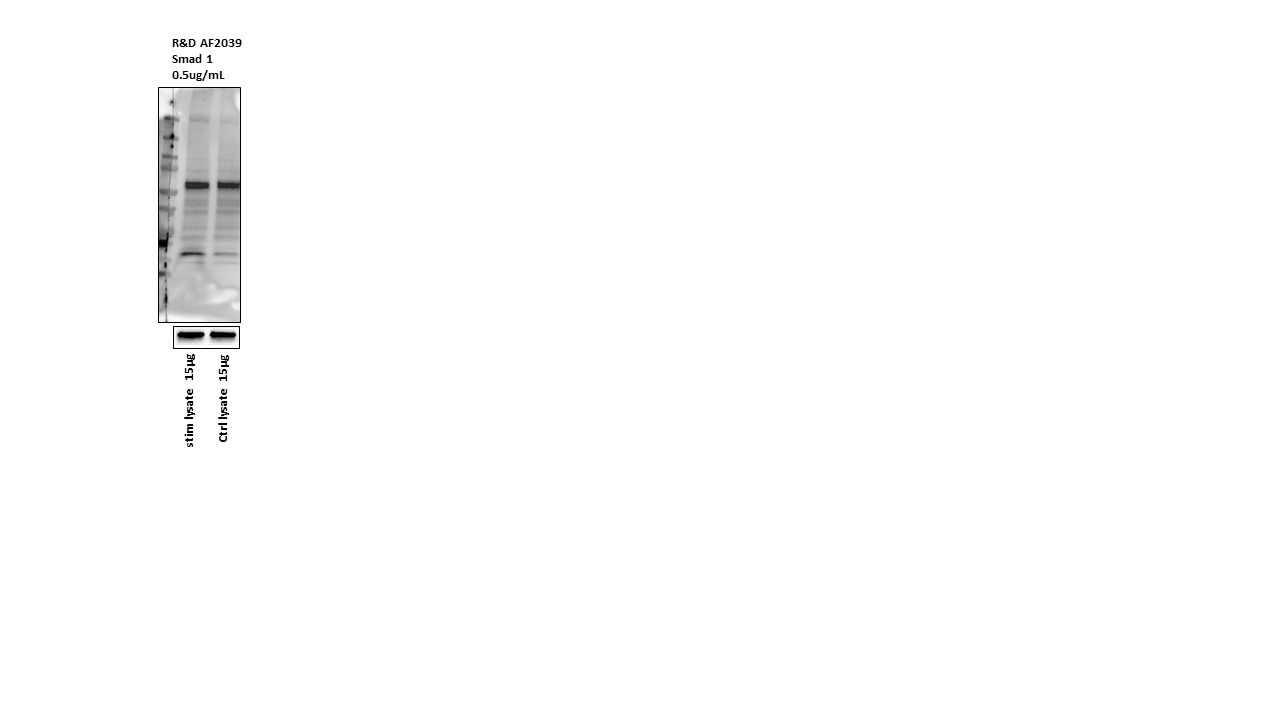Human Smad1 Antibody Summary
Asn2-Met454
Accession # Q15797
Customers also Viewed
Applications
Please Note: Optimal dilutions should be determined by each laboratory for each application. General Protocols are available in the Technical Information section on our website.
Scientific Data
 View Larger
View Larger
Smad1 in Human Breast Cancer Tissue. Smad1 was detected in immersion fixed paraffin-embedded sections of human breast cancer tissue using Goat Anti-Human Smad1 Antigen Affinity-purified Polyclonal Antibody (Catalog # AF2039) at 15 µg/mL overnight at 4 °C. Tissue was stained using the Anti-Goat HRP-DAB Cell & Tissue Staining Kit (brown; Catalog # CTS008) and counterstained with hematoxylin (blue). Specific labeling was localized to the nuclei of glandular epithelial cells. View our protocol for Chromogenic IHC Staining of Paraffin-embedded Tissue Sections.
 View Larger
View Larger
Detection of Human Smad1 by Western Blot. Western blot shows lysates of HepG2 human hepatocellular carcinoma cell line, MBA-MB-468 human breast cancer cell line, and HT-29 human colon adenocarcinoma cell line. PVDF membrane was probed with 0.5 µg/mL of Goat Anti-Human Smad1 Antigen Affinity-purified Polyclonal Antibody (Catalog # AF2039) followed by HRP-conjugated Anti-Goat IgG Secondary Antibody (Catalog # HAF109). A specific band was detected for Smad1 at approximately 63 kDa (as indicated). This experiment was conducted under reducing conditions and using Immunoblot Buffer Group 1.
 View Larger
View Larger
Smad1 in Human Breast. Smad1 was detected in immersion fixed paraffin-embedded sections of human breast array using Goat Anti-Human Smad1 Antigen Affinity-purified Polyclonal Antibody (Catalog # AF2039) at 15 µg/mL overnight at 4 °C. Tissue was stained using the Anti-Goat HRP-DAB Cell & Tissue Staining Kit (brown; Catalog # CTS008) and counterstained with hematoxylin (blue). Lower panel shows a lack of labeling if primary antibodies are omitted and tissue is stained only with secondary antibody followed by incubation with detection reagents. View our protocol for Chromogenic IHC Staining of Paraffin-embedded Tissue Sections.
 View Larger
View Larger
Detection of Human Smad1 by Simple WesternTM. Simple Western lane view shows lysates of HepG2 human hepatocellular carcinoma cell line and MDA-MB-468 human breast cancer cell line, loaded at 0.2 mg/mL. A specific band was detected for Smad1 at approximately 66 kDa (as indicated) using 5 µg/mL of Goat Anti-Human Smad1 Antigen Affinity-purified Polyclonal Antibody (Catalog # AF2039) followed by 1:50 dilution of HRP-conjugated Anti-Goat IgG Secondary Antibody (Catalog # HAF109). This experiment was conducted under reducing conditions and using the 12-230 kDa separation system.
 View Larger
View Larger
Detection of Mouse Smad1 by Western Blot Up-regulation of BMP signaling in the Fstl1-/- ureter and kidney.(A) Western blots of pSmad1/5/8, Smad1, pAKT (Ser473), AKT, and beta -actin from E15.5 (left panel) and E16.5 (second panel) ureter protein, E18.5 kidney protein (third panels), and HEK293 cells treated with the conditioned media containing BMP4 (20 ng/ml) transfected either with the Fstl1 or pcDNA3.1 vector (Mock) for 30 min (right panels). (B) Quantitative real-time PCR of Bmp2 (n = 5, p = 0.35), Bmp4 (n = 4, p = 0.73), Bmp5 (n = 5, p = 0.63), Bmp7 (n = 5, p = 0.50), TGF-beta 1 (n = 5, p = 0.51), Alk3 (n = 6, p = 0.40), Alk6 (n = 5, p = 0.21), Alk5 (n = 4, p = 0.47), BmprII (n = 6, p = 0.73), ActrIIa (n = 5, p = 0.97), and ActrIIb (n = 5, p = 0.73) from E16.5 ureters. (C) Co-immunoprecipitation of Myc-Fstl1 and HA-tagged BMP/TGF-beta receptors in HEK293 cells. Myc-Fstl1 can be immunoprecipitated with the anti-c-Myc antibody. Note that HA-ALK6 was co-immunoprecipitated by the anti-c-Myc and detected by the anti-HA antibody (lane 4). Scale bar: 40µm. Image collected and cropped by CiteAb from the following publication (https://dx.plos.org/10.1371/journal.pone.0032554), licensed under a CC-BY license. Not internally tested by R&D Systems.
Preparation and Storage
- 12 months from date of receipt, -20 to -70 °C as supplied.
- 1 month, 2 to 8 °C under sterile conditions after reconstitution.
- 6 months, -20 to -70 °C under sterile conditions after reconstitution.
Background: Smad1
Smads are a family of intracellular proteins that transmit transforming growth factor beta (TGF-beta ) superfamily signals from the cell surface to the nucleus. Upon signaling by some BMP family members, Smad1 is phosphorylated resulting in its association with the common-mediator subunit, Smad4. This heteromeric complex then translocates into the nucleus to exert transcriptional comodulator activity.
Product Datasheets
Citations for Human Smad1 Antibody
R&D Systems personnel manually curate a database that contains references using R&D Systems products. The data collected includes not only links to publications in PubMed, but also provides information about sample types, species, and experimental conditions.
8
Citations: Showing 1 - 8
Filter your results:
Filter by:
-
Yes-associated protein (YAP) is a negative regulator of chondrogenesis in mesenchymal stem cells.
Authors: Karystinou A, Roelofs AJ, Neve A et al.
Arthritis Res Ther.
-
Growth inhibitory activity of bone morphogenetic protein 4 in human glioblastoma cell lines is heterogeneous and dependent on reduced SOX2 expression
Authors: E Dalmo, P Johansson, M Niklasson, I Gustavsson, S Nelander, B Westermark
Mol. Cancer Res., 2020-03-31;0(0):.
Species: Human
Sample Types: Cell Lysate
Applications: Western Blot -
Urinary IgG4 and Smad1 Are Specific Biomarkers for Renal Structural and Functional Changes in Early Stages of Diabetic Nephropathy
Authors: Toshio Doi, Tatsumi Moriya, Yui Fujita, Naoto Minagawa, Masaru Usami, Tomoko Sasaki et al.
Diabetes
-
MicroRNA-155 controls RB phosphorylation in normal and malignant B lymphocytes via the noncanonical TGF-beta1/SMAD5 signaling module.
Authors: Jiang D, Aguiar R
Blood, 2013-10-17;123(1):86-93.
Species: Human
Sample Types: Cell Lysates
Applications: Western Blot -
Ca2+/S100 proteins act as upstream regulators of the chaperone-associated ubiquitin ligase CHIP (C terminus of Hsc70-interacting protein).
Authors: Shimamoto, Seiko, Kubota, Yasuo, Yamaguchi, Fuminori, Tokumitsu, Hiroshi, Kobayashi, Ryoji
J Biol Chem, 2013-01-23;288(10):7158-68.
Species: Human
Sample Types: Protein
Applications: Western Blot -
Endoglin Requirement for BMP9 Signaling in Endothelial Cells Reveals New Mechanism of Action for Selective Anti-Endoglin Antibodies
Authors: Olivier Nolan-Stevaux, Wendy Zhong, Stacey Culp, Kathy Shaffer, Joseph Hoover, Dineli Wickramasinghe et al.
PLoS ONE
-
Quantitative kinetics analysis of BMP2 uptake into cells and its modulation by BMP antagonists.
Authors: Alborzinia H, Schmidt-Glenewinkel H, Ilkavets I, Breitkopf-Heinlein K, Cheng X, Hortschansky P, Dooley S, Wolfl S
J Cell Sci, 2012-10-17;126(0):117-27.
Species: Human
Sample Types: Protein
Applications: Western Blot -
Fstl1 antagonizes BMP signaling and regulates ureter development.
Authors: Xu J, Qi X, Gong J
PLoS ONE, 2012-04-02;7(4):e32554.
Species: Mouse
Sample Types: Whole Tissue
Applications: IHC
FAQs
No product specific FAQs exist for this product, however you may
View all Antibody FAQsReviews for Human Smad1 Antibody
Average Rating: 4 (Based on 2 Reviews)
Have you used Human Smad1 Antibody?
Submit a review and receive an Amazon gift card.
$25/€18/£15/$25CAN/¥75 Yuan/¥2500 Yen for a review with an image
$10/€7/£6/$10 CAD/¥70 Yuan/¥1110 Yen for a review without an image
Filter by:























